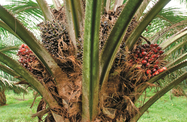Steady global demand for palm oil and improved weather conditions ending last year’s drought should help Malaysia’s agriculture sector recover from a decline in 2016, boosting returns for growers and processors and helping to ease inflation.

In its annual report issued in late March, the Bank Negara Malaysia (BNM) – the country’s central bank – forecast the agriculture sector to expand by 4% this year, contributing 0.3 percentage points to GDP growth.
“On the supply side, all economic sectors are projected to register positive growth in 2017,” the BNM report said. “The agriculture sector is expected to rebound as yields recover from the El Niño weather phenomenon.”
Warmer than usual seasonal temperatures related to El Niño saw production decline 5.1% last year, following a 1.2% decrease in 2015. This contributed to a decline in GDP growth, which hit 4.2% in 2016, down from 5% the year before, according to the Department of Statistics Malaysia (DOSM).
Agriculture currently makes up 8.1% of GDP, down from 11.5% in 2011. While the latter figure does reflect higher commodity prices at the time, the decline in the sector’s contribution has continued for decades as Malaysia’s economy has shifted towards manufacturing and services.
Nonetheless, agriculture remains a key facet of the country’s macroeconomic profile, with an improved performance from the industry this year likely to support growth in downstream industries such as food and edible oil processing. This should help to bring about the BNM’s GDP growth forecast of between 4.3% and 4.8% this year.
Palm oil market
According to the latest official data from 2015, palm oil made up 46.9% of agriculture’s contribution to GDP, followed by “other” (17.7%), livestock (10.7%), fishing (10.7%), rubber (7.2%) and forestry and logging (6.9%).
As the economy relies heavily on the crop, the impact of last year’s dry spell continues to be felt, with Malaysian traders importing above average quantities of palm oil and related products from Indonesia for processing.
Inbound shipments in the year to April were estimated to be up to 50% higher than the 40,000-50,000 tonnes usually imported each month, but these levels are expected to return to normal later in the year, local media reported at the end of March.
Analysts forecast the palm oil segment to continue improving through to the end of the year, in terms of both yields and productivity, driving up output to 19.85m tonnes, a 13% increase on 2016.
Higher yields, combined with increased imports, should push prices down to around RM2500 ($577) per tonne later in 2017, well below their four-year high of RM3000 ($692) per tonne recorded in January.
Sources of inflation
Lingering effects of the drought can also be seen in inflation figures, with the consumer price index up 5.1% year-on-year (y-o-y) in March, according to the DOSM – an eight-year high driven in part by rising food costs, especially for key staples.
The subindex for food and non-alcoholic drinks, which has a 30.2% weighting, climbed 4.1% y-o-y. Though some subgroups rose more slowly, those most affected by the drought increased at higher than average rates, with oil and fats up 38.8%, vegetables up 7.4% and meat up 3.4%.
Malaysia’s producer price index in March was higher still, as per the latest figures from the Department of Statistics, increasing by 9% y-o-y. This was mainly driven by rises in wholesale costs for agriculture, forestry and fisheries, which climbed by 13.8% over the preceding 12 months.
While production costs are likely to soften as yields rise and prices fall this year, they may feed into inflation for some time to come. In the latest revision of its inflation outlook for this year, the BNM projects year-end price increases of 3-4%, above the 3% ceiling in its earlier forecast.


